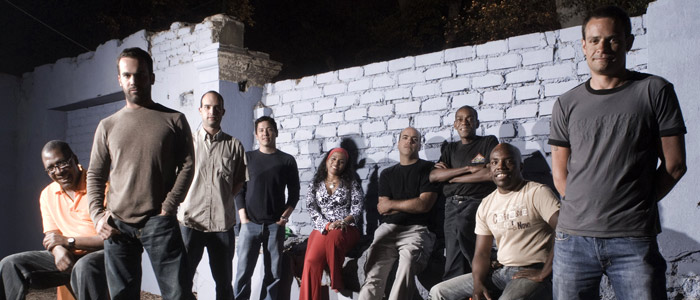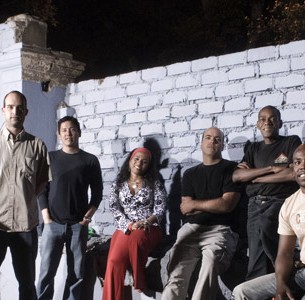
Novalima – CD Release Concert for Karimba on Friday, July 6, 2012 at 10:00pm
“The carimba was also called the ‘mark of fire’, as it referred to the branding iron and marking of slaves to identify their owners”, says Grimaldo del Solar. Speaking by phone from Lima, Peru, the songwriter, producer and beats programmer from Novalima, the acclaimed Afroperuvian electronica collective is defining for me the title of their upcoming CD, “Karimba” (ESL Music – September 13, 2011), which includes their version of the classic song, ‘La Carimba’ with the legendary Pepe Vasquez as invited vocalist. He continues to explain that this title was chosen not just because of the concept of race marking individuals’ experiences for life, but also to identify their music as being culturally marked by the melodies and rhythms of African-descendant Peruvians.
This innovative blending of centuries-old Afroperuvian rhythms first brought Novalima to international attention about a decade ago, when the project was formed with Del Solar and each of its three other founders based on different continents. Keyboardist Ramon Perez-Prieto had stayed in Lima, Del Solar had taken off to Barcelona, “to seek out fresh air” he says, while guitarist Rafael Morales had ended up in London and bassist Carlos Li Carrillo in Hong Kong. Being high school friends who had played in bands together for some time, they continued to compose and play together in cyberspace, creating and sharing tracks online.
At that time, Del Solar comments, they were taking their cues from pioneering Latin electronica projects such as Gotan Project, Paris-based Uruguayans and Argentineans who were bringing in tango into an electronic mix, and Sidestepper, led by Colombia-based UK producer Richard Blair who was incorporating the Afro rhythms of that land into his creations. But the backgrounds of Novalima’s members made it almost inevitable that their reggae, rap and dub-infused compositions would reference Afroperuvian rhythms – Morales’ great-grandmother, a famed musician, composer and musicologist had compiled Afroperuvian music and first documented many of its classics in musical scores.
All four founders have returned to Lima as the project continues to develop, now incorporating well-established Afroperuvian musicians such as vocalist Milagros Guerrero and cajon player Marcos Mosquera into the group and the live shows. Their last CD, ‘Coba Coba’ was nominated for a Latin Grammy, and their song ‘Machete’ is the title track of the soundtrack of Robert Rodriguez’ movie by the same name.
I wondered what it is that gives Novalima’s compositions the distinct characteristics that really set it apart from other Afrolatin electronica. Del Solar responds that it has to do bringing in the distinctive Afroperuvian rhythmic component created by the ancient sounds of the slave instruments such as the African-derived cowbell, quijada and the cajon (the two latter made from donkey jawbone and crates, respectively) in syncopated intertwining with the acoustic Spanish guitar. Additionally, he comments, as the Afroperuvian community lived isolated in only two regions, one to the south of Lima and the other along the far northern coast, many of their melodies have survived in a very pure form. Novalima’s compositions (which he notes, do not merely sample, all the materials are recorded) build upon these ancient, pure rhythms taking them in amped up form into the 21st century dance club.
And clubs world-round have certainly embraced Novalima’s sound, which speaks to the fact that their music is also marked by a celebratory call to the dance floor, says Del Solar. But Novalima’s music hasn’t just been about making us move to the beats. Del Solar considers their collective to be a second generation of Latin electronica (post-Gotan and post-Sidestepper) which has led a whole new third generation of producers to discover the roots of their own heritages. But even more importantly, Novalima helped bring the cultural offerings of the Afro community of Peru to the world’s attention, developing in Peruvians themselves a new awareness and pride in the immense cultural richness of the African heritage of their land.
